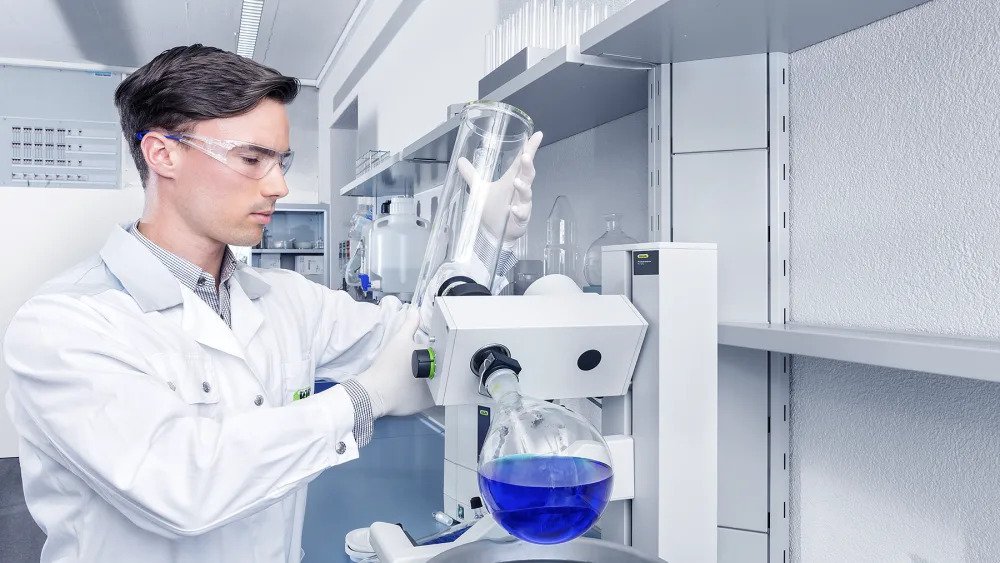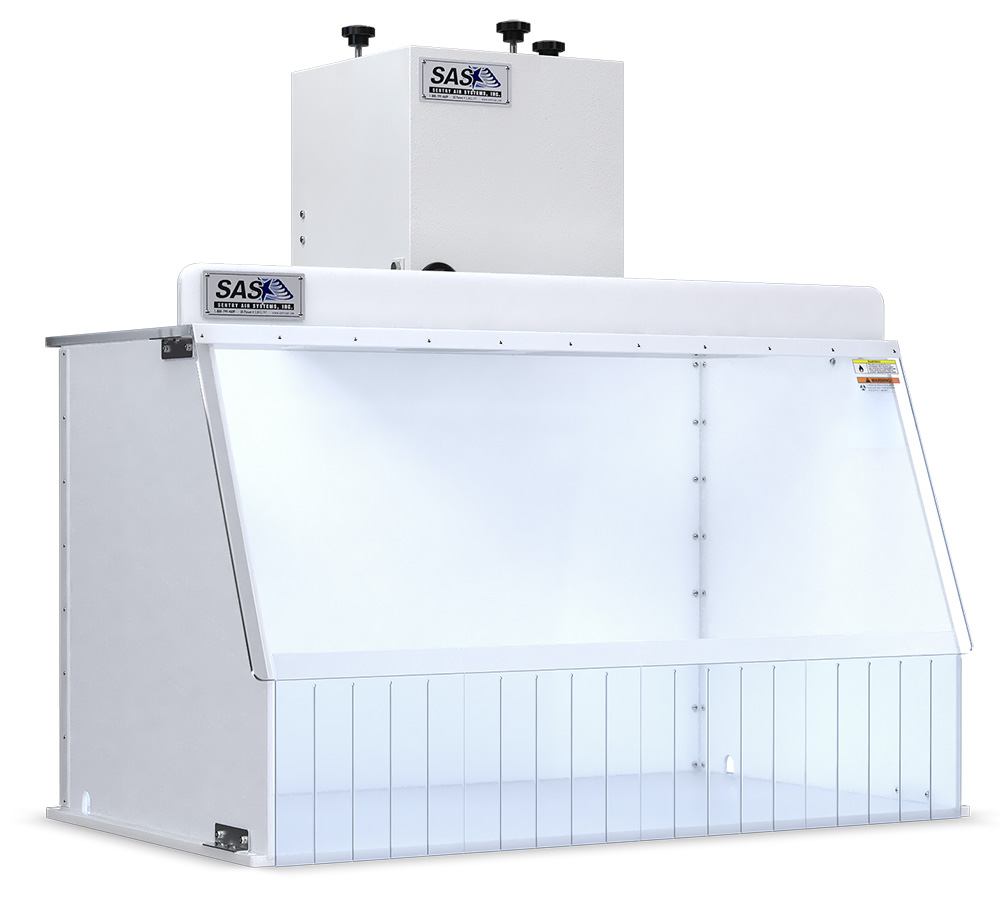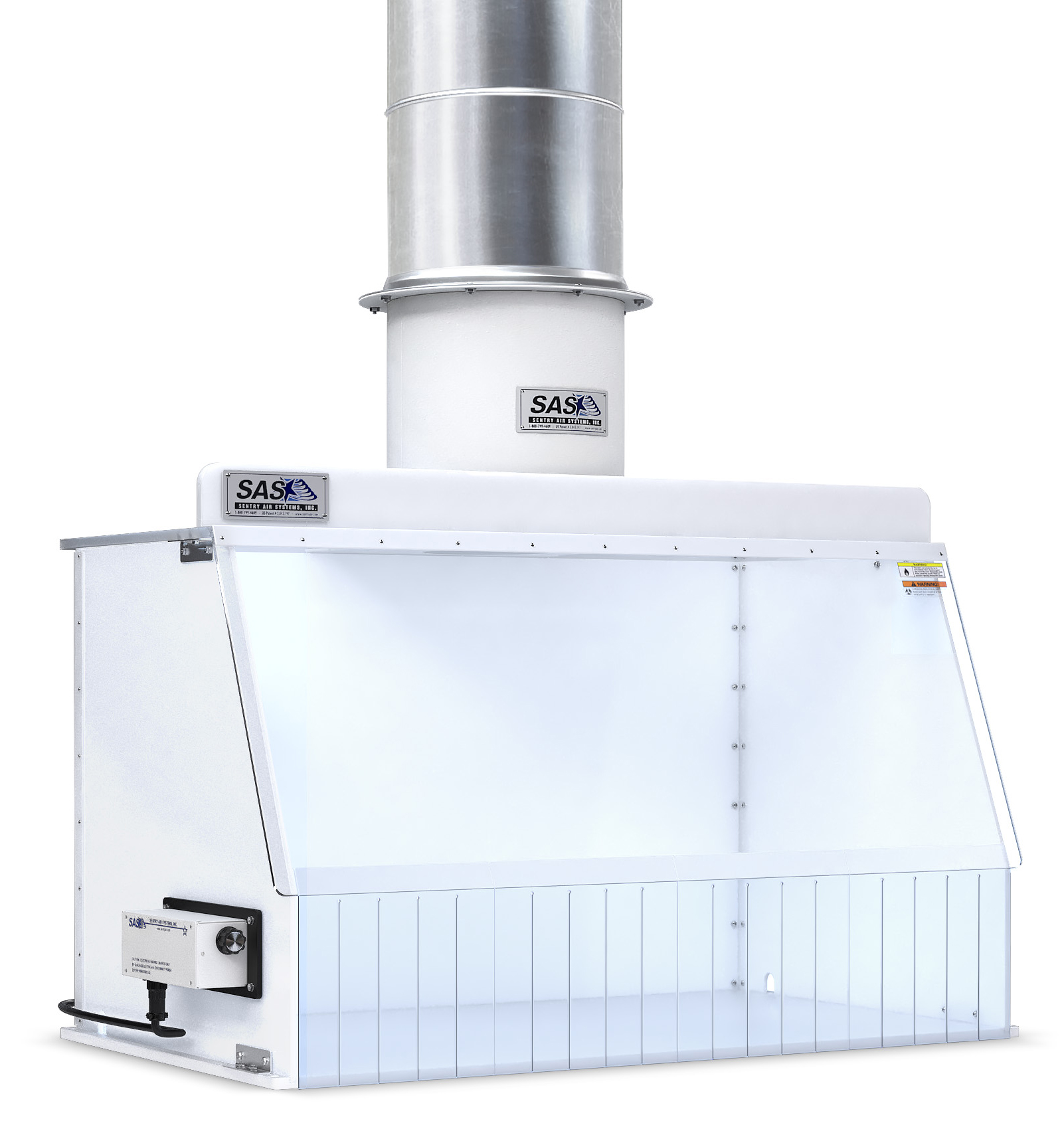
Rotary evaporators can release hazardous solvent fumes while using or cleaning the system, or while emptying the solvent trap (UCLA, 2010). Operators should consider fume inhalation risks and utilize respiratory engineering controls, such as a ductless fume hood or exhaust hood, to protect their safety and the overall laboratory’s safety.
What are Rotary Evaporators?

IKA Rotary Evaporator (Source)
Rotary evaporators, or rotovaps, use an increased temperature and reduced pressure to quickly remove solvents from less volatile samples (Rotary Evaporation, 2021). Rotary evaporators spin the flask containing the sample to increase the surface area while heating it in a water bath. Meanwhile, the vacuum reduces the pressure of the sample to lower the boiling point of the solvent (Rotary Evaporation, 2021). Once the solvent boils, it turns to vapor, then cooled through the condenser, and is collected in the solvent trap or flask. Rotary evaporators efficiently and gently remove solvents from the sample while dramatically reducing procedure time (Nichols, 2022). This process exposes the sample to a lower temperature, because of the reduced pressure, in turn protecting the sample from excessive heat.
Rotary Evaporator Applications

Ulrich Dyer of Woodlab Distillery uses a rotary evaporator to distill gin at lower temperatures creating fresher notes in a highly concentrated distillate. (Source)
Rotary evaporators are very common in everyday laboratory procedures and can be used to distill, dry, recover, and extract samples (LabX, 2021). Rotary evaporators can also be used for:
• Create concentrated solutions or suspensions (KNF)
• Crystallization or recrystallization (KNF)
• Solvent distillation and recycling (KNF)
• Chemical synthesis (KNF)
• Prepare distillates and extracts for cooking (KNF)
• Extractions for biofuel research and the oil and gas industry (Darcel, 2022)
• Extract flavor for food and alcohol flavorings (Darcel, 2022)
Rotary Evaporator Safety

Close-up of a rotary evaporator’s boiling flask in water bath. (Source)
Due to the use of high temperature, reduced pressure, and volatile chemicals, operating rotary evaporators requires following safety guidelines to ensure the operator’s safety as well as the overall lab safety. The different components of a rotary evaporator create distinct safety concerns including (Miller, Liu, 2017):
• Pinch point from the motor or moving parts
• Implosion and explosion from vacuum’s reduced pressure
• Inhalation of harmful fumes if solvent vapors escape
• Burns from the hot water bath
• Cuts from sharp glass of broken components
10 Rotary Evaporator Safety Rules

A lab technician practicing common safety procedures for rotary evaporators. (Source)
Laboratory professionals should always follow the manufacturer’s safety guidelines for safe rotary evaporator usage. In general, the following Rotary Evaporator safety rules offer ways to help improve safety.
1. Read Material Safety Data Sheets (MSDS) of all chemicals to ensure solvent and mixture can safely undergo rotary evaporation (Miller, Liu, 2017).
2. Don’t use highly reactive materials in a rotary evaporator to prevent possible explosions (UMass Amherst).
3. Wear appropriate PPE including eye protection, gloves, lab coat, shoes, etc. (Miller, Liu, 2017).
4. Ensure glassware has no cracks to prevent possible explosions/implosions (Miller, Liu, 2017).
5. Always empty the solvent trap or solvent collection flask before use to prevent mixing incompatible chemicals (UCLA, 2010).
6. Start with a clean bump trap to allow easy sample recovery and prevent contamination if bumping occurs (UCLA, 2010).
7. Securely fasten the flask and bump trap with clips to prevent breakage (UCLA, 2010).
8. Use the lowest possible temperature for boiling to prevent bumping (Miller, Liu, 2017).
9. Use in a fume hood or exhaust hood to prevent vapors from releasing into the lab (LabX, 2021).
10. Ventilate properly after use before disassembly to prevent the release of solvent vapors (LabX, 2021).
When to Use a Fume Hood
Utilizing a fume hood during rotary evaporation can help protect users from inhaling hazardous solvent fumes and injuries from implosion/explosion. Below are safety considerations for laboratories to examine when determining when to use a fume hood for rotary evaporation.
• Using volatile solvents that create toxic or noxious fumes – Solvent vapors can escape from a rotary evaporator posing potential health risks (O’Driscoll, 2018). Certain chemicals create more of a risk. See the Solvent Fumes discussion in the next section for more information.
• When there’s a risk of explosion or implosion – The fume hood can help provide a protective barrier between the user and the rotary evaporator to contain broken glass or pieces (O’Driscoll, 2018).
• To protect against other safety concerns such as pinch points or burns – Fast moving parts and high temperatures can cause safety hazards. The fume hood offers a protected area to separate it from the user helping to remove additional safety concerns (O’Driscoll, 2018).
Solvent Fume Exposure from Rotary Evaporators
Rotary evaporation utilizes a wide variety of different solvents. Solvent fume inhalation can occur while emptying the solvent trap or collection flask, during disassembly, and during use especially when using toxic solvents that are known to produce noxious fumes (O’Driscoll, 2018). Exposure side effects can vary, but protecting against any exposure can help employees and colleagues feel safer during work. OSHA regulates the exposure of most of the commonly used solvents for rotary evaporation. OSHA’s permissible exposure limit (PEL) is legally required and enforced for all workplaces while the NIOSH recommended exposure limit (REL) provides additional safety precautions. The chart summarizes common solvents, OSHA PEL, NIOSH REL, and possible health risks from inhalation (Miller, Liu, 2017).
| Solvent | OSHA PEL | NIOSH REL | Possible Health Risks |
| Acetone | 1000 ppm (OSHA, 2022a) |
250 ppm (OSHA, 2022a) |
Highly flammable, eye irritation, drowsiness, dizziness, severe exposure can lead to organ toxicity (National Center for Biotechnology Information, 2022a) |
| Hexane | 500 ppm (OSHA, 2022c) |
50 ppm (OSHA, 2022c) |
Flammable, respiratory irritation, cough, mild depression, prolonged exposure can lead to organ damage and reduced fertility (National Center for Biotechnology Information, 2022i) |
| Pentane | 1000 ppm (OSHA, 2022d) |
120 ppm (OSHA, 2022d) |
Drowsiness, dizziness, high concentrations can lead to unconsciousness or death (National Center for Biotechnology Information, 2022m) |
| Heptane | 500 ppm (OSHA, 2021b) |
85 ppm (OSHA, 2021b) |
Coughing, difficulty breathing, drowsiness, or dizziness (National Center for Biotechnology Information, 2022h) |
| Acetonitrile | 40 ppm (OSHA, 2020a) |
20 ppm (OSHA, 2020a) |
Acute toxicity when inhaled. Nose/throat irritation. Very flammable/explosive when heated. (National Center for Biotechnology Information, 2022b) |
| Dichloromethane (DCM) |
25 ppm (OSHA, 2022b) |
Carcinogenic, anesthetic effects, nausea, drunkenness. (National Center for Biotechnology Information, 2022d) | |
| Chloroform | Ceiling: 50 ppm (OSHA, 2020b) |
Short term: 2 ppm (OSHA, 2020b) |
Toxic, carcinogenic, affects fetal development, organ damage (National Center for Biotechnology Information, 2022c) |
| Diethyl Ether | 400 ppm (OSHA, 2020c) |
Drowsiness, dizziness, organ damage, abnormal liver function (National Center for Biotechnology Information, 2022e) | |
| Ethanol | 1000 ppm (OSHA, 2020d) |
1000 ppm (OSHA, 2020d) |
Skin and eye irritation, high concentrations can cause CNS depression (National Center for Biotechnology Information, 2022f) |
| Methanol | 200 ppm (OSHA, 2021c) |
200 ppm (OSHA, 2021c) |
Acute toxicity, eye irritation, headache, fatigue, sleepiness. High exposure: CNS depression, optic nerve damage (National Center for Biotechnology Information, 2022k) |
| Isopropyl Alcohol (IPA) |
400 ppm (OSHA, 2020e) |
400 ppm (OSHA, 2020e) |
Mild eye irritation and upper respiratory irritation. High exposure: anesthetic (National Center for Biotechnology Information, 2022j) |
| Tetrahydrofuran (THF) |
200 ppm (OSHA, 2021d) |
200 ppm (OSHA, 2021d) |
Eye and respiratory irritation, carcinogenic, flammable/explosive (National Center for Biotechnology Information, 2022n) |
| Ethyl Acetate | 400 ppm (OSHA, 2021a) |
400 ppm (OSHA, 2021a) |
Headache, respiratory irritation, dizziness, nausea, loss of consciousness (National Center for Biotechnology Information, 2022g) |
| Toluene | 200 ppm (OSHA, n.d.) |
200 ppm (OSHA, n.d.) |
Flammable, skin irritant, drowsiness, dizziness, fetal damage, organ damage (National Center for Biotechnology Information, 2022o) |
| Benzene | 1 ppm (NJ Department of Health, 2015) |
0.1 ppm (NJ Department of Health, 2015) |
Carcinogenic, coughing, wheezing, headache, convulsions, coma, sudden death (NJ Department of Health, 2015) |
| Dimethyl Formamide (DMF) |
10 ppm (NIOSH, 2019) |
10 ppm (NIOSH, 2019) |
Respiratory irritation, nausea, vomiting, liver damage, high blood pressure (National Center for Biotechnology Information, 2022l) |
Rotary Evaporator Fume Hood Solutions

Using a Ductless Fume Hood during rotary evaporation helps protect the operator from fume inhalation and other safety hazards.
Utilizing a rotary evaporator in a fume hood can offer lab technicians an added level of safety to help protect them from the inhalation of solvent fumes. Our fume hoods work best with diagonal condensers or diagonal setups of rotary evaporators. Custom fume hoods are available for Rotary Evaporators requiring a higher clearance workspace. Sentry Air Systems offers two great solutions constructed of all chemical-resistant materials:
• Ductless Fume Hoods
• Ducted Hoods with Inline Fan (Exhaust Hoods)
Ductless Fume Hoods
Ductless Fume Hoods create a recirculating airflow pattern by drawing solvent fumes into the high-quality filtration system and releasing filtered air back into the workspace. This type of fume hood offers an easy setup, reduced energy costs, and portability.
| Benefits | Easy to Install – no ductwork Portable – easy to move to a new location Energy savings from reduced cooling/heating and makeup air creation Environmentally Friendly |
| Filters Available | Activated Carbon Specialty Blended Filter Media (acid gas, aldehyde, ammonia, and formaldehyde) Combination of Activated Carbon and HEPA (up to 99.97% efficiency on particles down to 0.3 microns) |
| Inner Dimensions | Depth: 23.5” Height: 24” Widths Available: 24”, 30”, 40”, 50”, 60”, and 70” |
| Air Volume | Up to 300 CFM |
| Max Operating Temperature | 170° F (76° C) |
Ducted Fume Hoods with Inline Fan (Exhaust Hoods)
Ducted Fume Hoods with Inline Fan offer a chemical fume control solution for especially volatile organic compounds or toxic gases that have issues with being filtered. This system uses the inline fan to pull solvent fumes away from the operator through ductwork and released outside of the building. Please consult local, state, and federal agencies for all applicable exhaust ventilation guidelines.
| Benefits | Outside ducting – provides additional safety for toxic gases Continuous fume removal Durable and compatible with a variety of chemicals |
| Inner Dimensions | Depth: 23.5” Height: 24” Widths Available: 24”, 30”, 40”, 50”, 60”, and 70” |
| Air Volume | Variable speed control from 240 to 700 CFM |
| Max Operating Temperature | 150° F (66° C) |
Protect your lab from rotary evaporator safety hazards with durable fume hoods from Sentry Air!
Call us today! 1-800-799-4609 | 1-713-690-2153
Related Blogs
• Laboratory Fume Hoods
• Reducing Exposure of Hazardous Organic Solvents
References
Darcel, Colin. (2022, January). What are Rotovaps and How Can They be Used? Maratek. Retrieved July 21, 2022 from: https://www.maratek.com/blog/what-are-rotovaps-and-how-can-they-be-used.
KNF. Rotary Evaporation. Retrieved July 21, 2022 from: https://knf.com/en/us/solutions/lab-applications/rotary-evaporation
LabX. (2021, May). Rotary Evaporator Safety. Retrieved July 21, 2022 from: https://www.labx.com/resources/rotary-evaporator-safety/369
Miller, Kali & Liu, Deborah. (2017, August). Rotary Evaporator. Beckman Institute. Retrieved July 21, 2022 from: https://braungroup.beckman.illinois.edu/files/2018/02/SOP_BI-001_Rotovap-1.pdf.
National Center for Biotechnology Information (2022-a). PubChem Compound Summary for CID 180, Acetone. Retrieved July 21, 2022 from: https://pubchem.ncbi.nlm.nih.gov/compound/180.
National Center for Biotechnology Information (2022-b). PubChem Compound Summary for CID 6342, Acetonitrile. Retrieved July 21, 2022 from: https://pubchem.ncbi.nlm.nih.gov/compound/6342.
National Center for Biotechnology Information (2022-c). PubChem Compound Summary for CID 6212, Chloroform. Retrieved July 21, 2022 from: https://pubchem.ncbi.nlm.nih.gov/compound/6212.
National Center for Biotechnology Information (2022-d). PubChem Compound Summary for CID 6344, Dichloromethane. Retrieved July 21, 2022 from: https://pubchem.ncbi.nlm.nih.gov/compound/6344.
National Center for Biotechnology Information (2022-e). PubChem Compound Summary for CID 3283, Diethyl Ether. Retrieved July 21, 2022 from: https://pubchem.ncbi.nlm.nih.gov/compound/3283.
National Center for Biotechnology Information (2022-f). PubChem Compound Summary for CID 702, Ethanol. Retrieved July 21, 2022 from: https://pubchem.ncbi.nlm.nih.gov/compound/702.
National Center for Biotechnology Information (2022-g). PubChem Compound Summary for CID 8857, Ethyl Acetate. Retrieved July 21, 2022 from: https://pubchem.ncbi.nlm.nih.gov/compound/8857.
National Center for Biotechnology Information (2022-h). PubChem Compound Summary for CID 8900, Heptane. Retrieved July 21, 2022 from: https://pubchem.ncbi.nlm.nih.gov/compound/8900.
National Center for Biotechnology Information (2022-i). PubChem Compound Summary for CID 8058, Hexane. Retrieved July 21, 2022 from: https://pubchem.ncbi.nlm.nih.gov/compound/8058.
National Center for Biotechnology Information (2022-j). PubChem Compound Summary for CID 3776, Isopropyl Alcohol. Retrieved July 21, 2022 from: https://pubchem.ncbi.nlm.nih.gov/compound/3776.
National Center for Biotechnology Information (2022-k). PubChem Compound Summary for CID 887, Methanol. Retrieved July 21, 2022 from: https://pubchem.ncbi.nlm.nih.gov/compound/887.
National Center for Biotechnology Information (2022-l). PubChem Compound Summary for CID 6228, N,N-dimethylformamide. Retrieved July 21, 2022 from https://pubchem.ncbi.nlm.nih.gov/compound/6228.
National Center for Biotechnology Information (2022-m). PubChem Compound Summary for CID 8003, Pentane. Retrieved July 21, 2022 from: https://pubchem.ncbi.nlm.nih.gov/compound/8003.
National Center for Biotechnology Information (2022-n). PubChem Compound Summary for CID 8028, Tetrahydrofuran. Retrieved July 21, 2022 from: https://pubchem.ncbi.nlm.nih.gov/compound/Tetrahydrofuran.
National Center for Biotechnology Information (2022-o). PubChem Compound Summary for CID 1140, Toluene. Retrieved July 21, 2022 from: https://pubchem.ncbi.nlm.nih.gov/compound/1140.
New Jersey Department of Health. (2015, July). Benzene. NJ.gov. Retrieved July 21, 2022 from: https://nj.gov/health/eoh/rtkweb/documents/fs/0197.pdf.
Nichols, Lisa. (2022, April). Overview of Rotary Evaporation. Chemistry LibreTexts. Retrieved July 21, 2022 from: https://chem.libretexts.org/Bookshelves/Organic_Chemistry/Organic_Chemistry_Lab_Techniques_(Nichols)/05%3A_Distillation/5.06%3A_Rotary_Evaporation/5.6A%3A_Overview_of_Rotary_Evaporation.
NIOSH. (2019, October). Dimethyleformamide. NIOSH Pocket Guide to Chemical Hazards. Retrieved July 21, 2022 from: https://www.cdc.gov/niosh/npg/npgd0226.html.
O’Driscoll, Aimme. (2018, November). Deciding Whether or Not to Use a Fume Hood with Your Rotary Evaporator. Rotovaps.net. Retrieved July 21, 2022 from:
https://rotovaps.net/blogs/blog/should-you-use-a-fume-hood-with-a-rotovap.
OSHA. (2022, July-a). Acetone. OSHA Occupational Chemical Database. Retrieved July 21, 2022 from: https://www.osha.gov/chemicaldata/476.
OSHA. (2022, July-b). Dichloromethane. OSHA Occupational Chemical Database. Retrieved July 21, 2022 from: https://www.osha.gov/chemicaldata/572.
OSHA. (2022, June-c). Hexane. OSHA Occupational Chemical Database. Retrieved July 21, 2022 from: https://www.osha.gov/chemicaldata/112.
OSHA. (2022, June-d). Pentane. OSHA Occupational Chemical Database. Retrieved July 21, 2022 from: https://www.osha.gov/chemicaldata/98.
OSHA. (2021, April-a). Ethyl Acetate. OSHA Occupational Chemical Database. Retrieved July 21, 2022 from: https://www.osha.gov/chemicaldata/263.
OSHA. (2021, April-b). Heptane. OSHA Occupational Chemical Database. Retrieved July 21, 2022 from: https://www.osha.gov/chemicaldata/266.
OSHA. (2021, January-c). Methanol. OSHA Occupational Chemical Database. Retrieved July 21, 2022 from: https://www.osha.gov/chemicaldata/474.
OSHA. (2021, January-d). Tetrahydrofuran. OSHA Occupational Chemical Database. Retrieved July 21, 2022 from: https://www.osha.gov/chemicaldata/107.
OSHA. (2020, December-a). Acetonitrile. OSHA Occupational Chemical Database. Retrieved July 21, 2022 from: https://www.osha.gov/chemicaldata/569.
OSHA. (2020, December-b). Chloroform. OSHA Occupational Chemical Database. Retrieved July 21, 2022 from: https://www.osha.gov/chemicaldata/477.
OSHA. (2020, December-c). Diethyl Ether. OSHA Occupational Chemical Database. Retrieved July 21, 2022 from: https://www.osha.gov/chemicaldata/437.
OSHA. (2020, December-d). Ethanol. OSHA Occupational Chemical Database. Retrieved July 21, 2022 from: https://www.osha.gov/chemicaldata/1034.
OSHA. (2020, December-e). Isopropyl Alcohol. OSHA Occupational Chemical Database. Retrieved July 21, 2022 from: https://www.osha.gov/chemicaldata/475.
OSHA. Toluene – Occupational Exposure Limits. Safety and Health Topics. Retrieved July 21, 2022 from: https://www.osha.gov/toluene/occupational-exposure-limits.
Rotary Evaporation. (2021, August). Chemistry LibreTexts. Retrieved July 21, 2022 from: https://chem.libretexts.org/Ancillary_Materials/Demos_Techniques_and_Experiments/General_Lab_Techniques/Rotary_Evaporation.
UCLA. (2010, April). How to use a Rotary Evaporator. Retrieved July 21, 2022 from: https://www.chem.ucla.edu/~bacher/Specialtopics/rotavap.html.
U Mass Amherst. Rotary Evaporator Fact Sheet. Retrieved July 21, 2022 from:
https://ehs.umass.edu/sites/default/files/Rotary%20Evaporator%20Fact%20Sheet.pdf.
Go Back to Other Section
What are Rotary Evaporators | Rotary Evaporator Applications | Rotary Evaporator Safety | 10 Rotary Evaporator Safety Rules | When to Use a Fume Hood | Solvent Fume Exposure from Rotary Evaporators | Rotary Evaporator Fume Hood Solutions | Ductless Fume Hoods | Ducted Fume Hoods with Inline Fan | Related Blogs

 Made in the USA
Made in the USA


